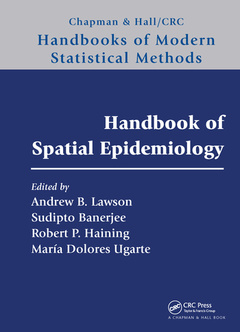Handbook of Spatial Epidemiology Chapman & Hall/CRC Handbooks of Modern Statistical Methods Series

Handbook of Spatial Epidemiology explains how to model epidemiological problems and improve inference about disease etiology from a geographical perspective. Top epidemiologists, geographers, and statisticians share interdisciplinary viewpoints on analyzing spatial data and space?time variations in disease incidences. These analyses can provide important information that leads to better decision making in public health.
The first part of the book addresses general issues related to epidemiology, GIS, environmental studies, clustering, and ecological analysis. The second part presents basic statistical methods used in spatial epidemiology, including fundamental likelihood principles, Bayesian methods, and testing and nonparametric approaches. With a focus on special methods, the third part describes geostatistical models, splines, quantile regression, focused clustering, mixtures, multivariate methods, and much more. The final part examines special problems and application areas, such as residential history analysis, segregation, health services research, health surveys, infectious disease, veterinary topics, and health surveillance and clustering.
Spatial epidemiology, also known as disease mapping, studies the geographical or spatial distribution of health outcomes. This handbook offers a wide-ranging overview of state-of-the-art approaches to determine the relationships between health and various risk factors, empowering researchers and policy makers to tackle public health problems.
Introduction. Basic Methods. Special Methods. Special Problems and Applications. Index.
Andrew B. Lawson is a professor of biostatistics in the Division of Biostatistics, Department of Public Health Sciences, College of Medicine at the Medical University of South Carolina (MUSC). He is an MUSC eminent scholar and American Statistical Association (ASA) fellow. He is also an advisor in disease mapping and risk assessment for the World Health Organization, the founding editor of the journal Spatial and Spatio-Temporal Epidemiology, and the author of eight books, including the highly regarded Chapman & Hall/CRC book Bayesian Disease Mapping: Hierarchical Modeling in Spatial Epidemiology, Second Edition. He has published more than 150 journal articles on spatial epidemiology, spatial statistics, and related areas. He earned a PhD in spatial statistics from the University of St. Andrews.
Sudipto Banerjee is a professor and chair in the Department of Biostatistics at the University of California, Los Angeles. He is an elected fellow of the ASA, the Institute of Mathematical Statistics, and the International Statistical Institute. He is also a recipient of the Mortimer Spiegelman Award from the American Public Health Association. He is the author/coauthor of more than 100 peer-reviewed publications and two highly regarded Chapman & Hall/CRC books: Hierarchical Modeling and Analysis for Spatial Data, Second Edition and Linear Algebra and Matrix Analysis for Statistics. His research interests include hierarchical modeling and Bayesian inference for spatially referenced data.
Robert Haining retired as a professor of human geography from the University of Cambridge in September 2015. He is the author/coauthor of more than 150 articles and two books. His research focuses on the quantitative analysis of geographical data, including the geography of health, spatial representation, spatial sampling, exploratory data analysis, small-area estimation and hypothesis testing, spatial data analysis, and sp
Date de parution : 06-2020
17.8x25.4 cm
Date de parution : 04-2016
17.8x25.4 cm
Thèmes de Handbook of Spatial Epidemiology :
Mots-clés :
Car Prior; Spatial Epidemiology; spatial epidemiological data; Precision Matrix; spatial statistics; Spatial Scan Statistic; GIS; Prior Distribution; smoothed analysis of variance; Intrinsic Car Model; human and veterinary epidemiology; Posterior Predictive Distribution; spatial data analysis; Package INLA; linear quantile regression; Disease Mapping; Case Event Data; spatial distribution of health outcomes; Posterior Distributions; disease etiology; Quantile Regression; space–time variations in disease incidences; Smoothing Parameters; epidemiological problems; Seer Area; Ecological Modeling; Negative Binomial; Bayesian Modeling; Space Time Scan Statistic; Infectious Disease Modeling; Community Multi-Scale Air Quality Model; PTB; Scan Statistic; Data Set; Syndromic Surveillance; DP Mixture; Posterior Model Probabilities; Geostatistical Models; Ith County



